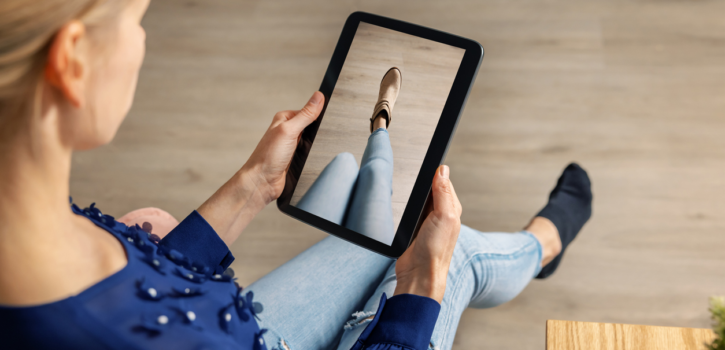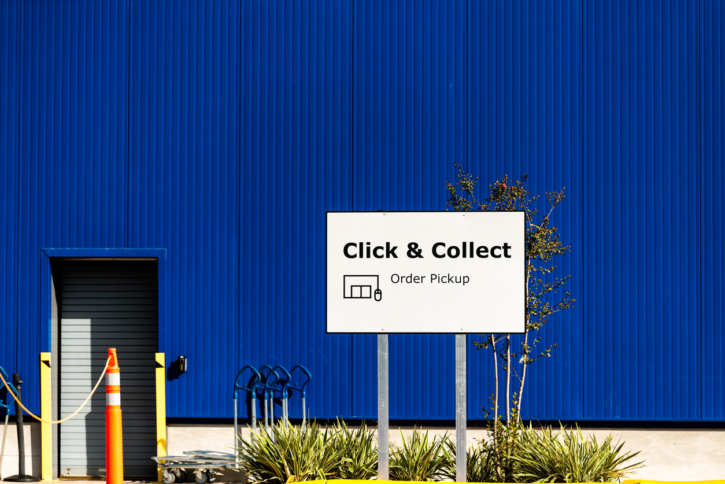E-commerce Virtual Try-on: The Complete Guid
Who hasn’t dreamt of being able to try on a pair of shoes before ordering them? Good news: it’s now possible with e-commerce virtual try-on! Consumers seeking immersive experiences will be delighted to try out this technology on your site. So what exactly is virtual fitting and what tool do you need to be able to set it up on your online store?
What is e-commerce virtual try-on?
Virtual try-on is an innovative technology that enables internet users to try on products virtually before ordering them,
These products may be:
- clothes
- accessories
- shoes
- makeup
Virtual try-on relies on augmented reality to simulate products on a user via their camera, enabling them to visualise different looks with a simple click on their face or body.
This technology solves the major drawback of e-commerce, which is not knowing whether an item will suit or fit you before you order it. This is particularly true for jeans, which are cut differently to suit different body shapes.
With virtual try-on, consumers can try on garments, without physically having them in their possession, via your e-commerce site.
And if the result is positive, they’ll be sure to leave you very good reviews!
What are the advantages of virtual try-on?
The chance to try items on at home
Previously, when people didn’t want to try on garments in store, they had two options:
- buy the items, try them on at home, then take them back to the shop if they didn’t fit
- order them, try them on at home, then return them if they didn’t fit.
Today, thanks to virtual try-on, these same people can switch up from medium to large with a click and try on their new clothes at home.
There is no longer a need to queue up for the changing rooms in a shop, or at the post office to send back a dress that’s too big or badly cut!
Greater time-saving for the consumer
From the consumers’ point of view, virtual try-on has a clear advantage: it saves them time. They no longer need to go to a shop to try on a pair of trousers or to a beauty counter to test an eye shadow. Internet users also save money, particularly if they live in rural areas where they would need to use their car to get to the town centre.
A personalised shopping experience
This technology also enables you to create a more personalised shopping experience by offering customers many ways to try things. You can save not only their sizes and the shape of their faces but also the colours they like. And in the virtual changing room, you can suggest clothes to go with the items chosen by customers. This will increase their average shopping basket, as they realise how well different items go together.
With all these advantages, virtual try-on will give your online store a real competitive edge.
A reduction in the number of returns
For online stores, these advantages are reflected in the reduction in the number of returns and refund requests. With virtual try-on, your customers will be able to visualise the products on their face or their skin before they buy. They’ll be more confident about ordering your products!
What products can be tried out virtually?
Virtual testing of makeup
Makeup is one of the best examples of items that can be tested from home. Even in a physical shop, it’s often not possible to try out a foundation or powder. And finding the right shade for your skin tone can sometimes be a real obstacle course, as each brand gives different references or codes to its colours. That doesn’t make it easy for the consumer to choose!
Thanks to virtual testing and augmented reality, those who love makeup will be able to visualise how different shades of lipstick or foundation will look on them without actually applying them.
Virtual try-on of accessories
Fashion accessories are another example of products that can be tried out online. Consumers looking for new pieces of jewellery or a new handbag can use the virtual try-on option to see what these items will look like with pieces from their wardrobe. They can also try on a pair of earrings with a necklace to see how these accessories work together!
Virtual try-on of glasses
Glasses are another example of items that can be tried on at home to make life easier. No more spreading out fifty pairs of glasses on the display table at the opticians. With this technology, customers can try on glasses to see how they look on their face before buying them, which will help them find the right style and size.
Virtual try-on of clothing
Customers of your e-commerce site will, of course, be able to try on T-shirts, dresses, skirts, jeans, jackets, swimming costumes and more. Virtual try-on will make it easier than ever to find the right size, cut and colour! No longer will your customers be disappointed when they open their parcels at home.
Virtual try-on of shoes
Obviously, virtual try-on also enables customers to try out different pairs of shoes. This helps consumers to find a style that suits their personality. To give a practical example: Laura had seen a friend on social media wearing some Adidas Gazelle trainers. She decided to buy them online without having first tried them on. However, once she got them home and tried them on, they were a disaster: they didn’t work with the shape of her feet at all! To avoid this kind of problem, nothing beats virtual shoe-fitting. That would have enabled her to be aware of the problem before buying!
Which virtual try-on software should you choose for your online store?
Would you like to set up a virtual try-on option on your e-commerce site? Here are the three best virtual try-on technologies currently available on the market.
1. Fittingbox: the very realistic virtual try-on tool for glasses
Are you an optician? To boost your e-commerce sales of sunglasses during the summer and of prescription glasses all year round, we recommend the Fittingbox tool. It’s very simple to use. Available on all devices, this solution will enable you to offer internet users an immersive and interactive try-on experience using augmented reality.
This is what your customers’ screen will look like when they try on glasses on your e-commerce site:
2. Veesual AI: the virtual try-on software boosted by artificial intelligence
Veesual AI relies on artificial intelligence to enable users to try on clothing. This software will suit your website if you sell women’s ready-to-wear, menswear or swimwear.
Customers will not be able to see themselves directly but will be able to choose a model with whom they identify. They’ll then be able to switch clothes to try out a T-shirt with several different skirts, for example.
As a bonus, you’ll be able to offer a Mix & Match experience by suggesting certain clothing combinations to consumers.
3. CapCut: an online changing room
Following the same principle as Veesual AI, CapCut enables customers to try any item of clothing on models to compare different sizes and styles in real time from the comfort of their own home. The advantage of this virtual try-on software is that customers can personalise their experience. For example, they can choose from a varied range of poses and visuals (for example T-shirts with rolled-up sleeves).
Virtual try-on and e-commerce: summary
To sum up, virtual try-on is a revolutionary technology that solves the problems of shopping online. Those who have been apprehensive about buying online now have an excellent reason to try it. And for online stores, it means:
- an increase in sales
- a better understanding of customers’ expectations (you’ll be able to discover their size and style preferences and thus improve your offer of products)
- a reduction in the number of returns.
We therefore strongly advise you to implement this functionality on your site.
It will enable you to build customer loyalty and reassure visitors to your site, whether you sell fashion accessories, clothing, shoes or makeup.






